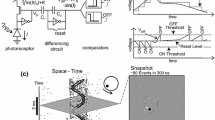Abstract
Image processing in digital computer systems usually considers visual information as a sequence of frames. These frames are from cameras that capture reality for a short period of time. They are renewed and transmitted at a rate of 25-30 fps (typical real-time scenario). Digital video processing has to process each frame in order to detect a feature on the input. In stereo vision, existing algorithms use frames from two digital cameras and process them pixel by pixel until it finds a pattern match in a section of both stereo frames. To process stereo vision information, an image matching process is essential, but it needs very high computational cost. Moreover, as more information is processed, the more time spent by the matching algorithm, the more inefficient it is. Spike-based processing is a relatively new approach that implements processing by manipulating spikes one by one at the time they are transmitted, like a human brain. The mammal nervous system is able to solve much more complex problems, such as visual recognition by manipulating neuron’s spikes. The spike-based philosophy for visual information processing based on the neuro-inspired Address-Event- Representation (AER) is achieving nowadays very high performances. The aim of this work is to study the viability of a matching mechanism in a stereo-vision system, using AER codification. This kind of mechanism has not been done before to an AER system. To do that, epipolar geometry basis applied to AER system are studied, and several tests are run, using recorded data and a computer. The results and an average error are shown (error less than 2 pixels per point); and the viability is proved.
Access this chapter
Tax calculation will be finalised at checkout
Purchases are for personal use only
Preview
Unable to display preview. Download preview PDF.
Similar content being viewed by others
References
Barnard, S.T., Fischler, M.A.: Computational Stereo. Journal ACM CSUR 14(4) (1982)
Dominguez-Morales, M., et al.: An approach to distance estimation with stereo vision using Address-Event-Representation. In: International Conference on Neural Information Processing, ICONIP (2011)
Dominguez-Morales, M., et al.: Live Demonstration: on the Distance Estimation of Moving Targets with a Stereo-Vision Aer System. In: ISCASS (2012)
Shepherd, G.M.: The Synaptic Organization of the Brain, 3rd edn. Oxford University Press (1990)
Lee, J.: A Simple Speckle Smoothing Algorithm for Synthetic Aperture Radar Images. Man and Cybernetics SMC-13 (1981)
Crimmins, T.: Geometric Filter for Speckle Reduction. Applied Optics 24, 1438–1443 (1985)
Linares-Barranco, A., et al.: AER Convolution Processors for FPGA. In: ISCASS (2010)
Sivilotti, M.: Wiring Considerations in analog VLSI Systems with Application to Field-Programmable Networks. Ph.D. Thesis, Caltech (1991)
Cope, B.: Implementation of 2D Convolution on FPGA, GPU and CPU. I.C. Report (2006)
Cope, B., et al.: Have GPUs made FPGAs redundant in the field of video processing? FPT (2005)
Lichtsteiner, P., Posh, C., Delbruck, T.: A 128×128 120dB 15 us Asynchronous Temporal Contrast Vision Sensor. IEEE Journal on Solid-State Circuits 43(2), 566–576 (2008)
Hartley, R., Zisserman, A.: Multiple View Geometry in Computer Vision, 2nd edn. Cambridge University Press (2004)
Jimenez-Fernandez, A., et al.: Building Blocks for Spike-based Signal Processing. In: IEEE International Joint Conference on Neural Networks, IJCNN (2010)
Rosenfeld, A.: First Textbook in Computer Vision: Picture Processing by Computer. Academic Press, New York (1969)
Tsai, R.Y.: A versatile camera calibration technique for high-accuracy 3D machine vision metrology using off-the-shelf TV cameras and lenses. IEEE Int. Journal Robotics and Automation. 3(4), 323–344 (1987)
Faugeras, O.: Three-dimensional computer vision: a geometric viewpoint. MIT Press (1993)
Author information
Authors and Affiliations
Editor information
Editors and Affiliations
Rights and permissions
Copyright information
© 2013 Springer-Verlag Berlin Heidelberg
About this paper
Cite this paper
Domínguez-Morales, M.J., Cerezuela-Escudero, E., Perez-Peña, F., Jimenez-Fernandez, A., Linares-Barranco, A., Jimenez-Moreno, G. (2013). On the AER Stereo-Vision Processing: A Spike Approach to Epipolar Matching. In: Lee, M., Hirose, A., Hou, ZG., Kil, R.M. (eds) Neural Information Processing. ICONIP 2013. Lecture Notes in Computer Science, vol 8226. Springer, Berlin, Heidelberg. https://doi.org/10.1007/978-3-642-42054-2_34
Download citation
DOI: https://doi.org/10.1007/978-3-642-42054-2_34
Publisher Name: Springer, Berlin, Heidelberg
Print ISBN: 978-3-642-42053-5
Online ISBN: 978-3-642-42054-2
eBook Packages: Computer ScienceComputer Science (R0)




